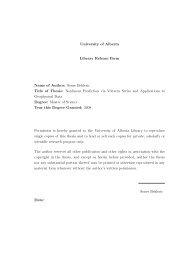Regularization of the AVO inverse problem by means of a ...
Regularization of the AVO inverse problem by means of a ...
Regularization of the AVO inverse problem by means of a ...
Create successful ePaper yourself
Turn your PDF publications into a flip-book with our unique Google optimized e-Paper software.
CHAPTER 2. <strong>AVO</strong> MODELING 19<br />
Assuming very small change in density, <strong>the</strong> last term in equation (2.34) cab be ignored and<br />
results in <strong>the</strong> following expression<br />
Rpp(θi) = 1<br />
2 (1 + tan2 θ) ∆Ip<br />
Ip<br />
− 4γ 2 sin 2 θ ∆Is<br />
. (2.36)<br />
The model parameters in this equation are <strong>the</strong> P-wave and S-wave impedance. This ap-<br />
proximation is used in Chapter 4 for <strong>the</strong> two-term <strong>AVO</strong> inversion <strong>problem</strong>.<br />
2.4 Comparison <strong>of</strong> approximations<br />
In this section, <strong>the</strong> various approximations are compared to <strong>the</strong> exact equation. Using <strong>the</strong><br />
P-wave velocity, S-wave velocity and density models in Table 2.1, <strong>the</strong> reflection coefficients<br />
are calculated and plotted against <strong>the</strong> angle <strong>of</strong> incidence up to <strong>the</strong> critical angle.<br />
Model Layer P-wave velocity (m/s) S-wave velocity (m/s) density (kg/m 3 )<br />
1 1 3000 1800 2200<br />
2 3200 2000 2250<br />
2 1 3000 1800 2200<br />
2 4000 2500 2400<br />
Table 2.1: Two layered models which are used for comparison <strong>of</strong> linear approximations<br />
to Zoeppritz equation (Rpp ).<br />
Equations (2.27), (2.31), and (2.34) are <strong>the</strong> same: <strong>the</strong> later two are rearranged forms <strong>of</strong> Aki<br />
and Richards’s approximation. Figure 2.2 shows <strong>the</strong> comparison <strong>of</strong> equations (2.24), (2.27),<br />
(2.29), (2.30), (2.32), and (2.36). For small layer contrast (model 1), all <strong>the</strong> approximations<br />
are in a good agreement with <strong>the</strong> exact equation up to angle range from 30 0 to 40 0 . Beyond<br />
this angle, some deviations are seen near <strong>the</strong> critical angle particularly for Shuey’s and Verm<br />
and Hilterman’s equations while <strong>the</strong> Fatti’s approximation extends quite well up to 50 0 .<br />
The rest <strong>of</strong> <strong>the</strong> approximations (Aki and Richards’s and Smith and Gidlow’s approximation)<br />
exactly coincides with <strong>the</strong> exact equation up to <strong>the</strong> critical angle. A similar comparison using<br />
model 2 shows a significant deviation. The Shuey’s approximation is in a good agreement<br />
up to only 25 0 . Aki and Richards’s and Smith and Gidlow’s approximation are <strong>the</strong> same<br />
equations. One is <strong>the</strong> rearrangement <strong>of</strong> <strong>the</strong> o<strong>the</strong>r so <strong>the</strong>y exactly coincides with each o<strong>the</strong>r<br />
but show some deviations from <strong>the</strong> exact solution. The Fatti’s approximation is almost<br />
exact as <strong>the</strong> later two up to 35 0 . The response <strong>of</strong> <strong>the</strong> reflection coefficient may vary from<br />
model to model i.e we may observe different behavior for each approximation. In general,<br />
those comparison show that at larger angle <strong>of</strong> incidence and/or larger model contrast, <strong>the</strong><br />
deviation from <strong>the</strong> exact is significant.<br />
Is









